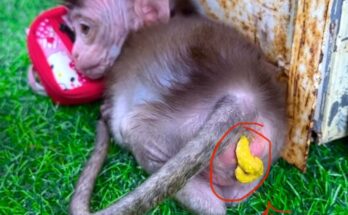Just like human infants, baby monkeys cry as a way to communicate their needs. Crying in baby monkeys can be triggered by a variety of factors including hunger, fear, loneliness, discomfort, or illness. Understanding the underlying cause and employing appropriate soothing techniques are essential for caregivers, researchers, and animal rehabilitation workers. Here are several methods to help soothe a crying baby monkey, grounded in both primate behavior and compassionate caregiving.
1. Physical Contact and Comfort
Physical closeness is one of the most effective ways to soothe a baby monkey. In the wild, baby monkeys cling to their mothers for warmth, security, and emotional bonding. Mimicking this natural behavior, caregivers can gently hold or cradle the infant. Skin-to-skin contact or wrapping the baby in a soft cloth simulates the warmth and pressure of the mother’s body, which often calms the monkey quickly.
2. Feeding and Hydration
Hunger or thirst is a common reason for crying. Feeding the baby with a suitable formula (such as a milk replacer designed for primates) can immediately address this need. It is important to follow veterinary guidance to ensure the formula is nutritionally balanced and appropriate for the monkey’s age. Offering hydration through clean water or an electrolyte solution may also be necessary, particularly in hot climates or after extended crying.
3. Creating a Safe and Calm Environment
Baby monkeys are highly sensitive to their surroundings. Loud noises, unfamiliar smells, or bright lights can cause distress. A quiet, warm, and dimly lit space that mimics the safety of a nest or tree canopy can reduce stress and help the baby feel secure. Providing soft bedding and familiar toys or objects can also add comfort.
4. Gentle Rocking or Motion
Rhythmic motion can have a calming effect on primates. Gently rocking the baby in your arms or placing them in a soft, secure carrier that allows for movement can help soothe their cries. In the wild, baby monkeys experience constant motion while clinging to their mothers as they move. Simulating this with slow, predictable movement can provide similar reassurance.
5. Vocal Soothing and Reassurance
Using a calm and gentle voice, or even soft humming, can mimic the soothing vocalizations of a monkey mother. Some caregivers also play recordings of natural jungle sounds or calming music, which can have a relaxing effect. These auditory cues help the baby associate the environment with safety and comfort.
6. Addressing Health Issues
Persistent crying despite comfort may signal pain or illness. Common health concerns in baby monkeys include gastrointestinal discomfort, parasites, or respiratory infections. A qualified veterinarian should examine any baby monkey with ongoing distress to rule out medical issues and provide treatment.
Conclusion
Soothe a crying baby monkey requires a blend of empathy, knowledge, and attentiveness. Mimicking maternal behaviors, ensuring basic needs are met, and creating a nurturing environment are all key strategies. By addressing both physical and emotional needs, caregivers can help young monkeys feel safe, secure, and loved—essential steps in their healthy development and emotional well-being.



